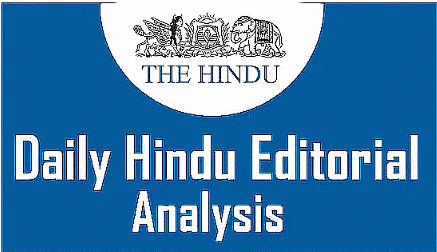UPSC Exam > UPSC Notes > Current Affairs & Hindu Analysis: Daily, Weekly & Monthly > The Hindu Editorial Analysis- 6th October 2023
The Hindu Editorial Analysis- 6th October 2023 | Current Affairs & Hindu Analysis: Daily, Weekly & Monthly - UPSC PDF Download

Inspiring colours
Why in News?
The Royal Swedish Academy of Sciences awarded the Nobel Prize in Chemistry 2023 to Moungi G Bawendi, Louis E Brus, and Alexei I Ekimov for their groundbreaking discovery and synthesis of quantum dots.
How did Scientists Discover Quantum Dots?
- Background:
- Traditionally, all pieces of a pure element, regardless of size, were believed to have identical properties due to the uniform distribution of electrons.
- However, about forty years ago, scientists discovered that nanoparticles on the nanoscale, typically 1 to 100 billionths of a meter in size, exhibited distinct behaviors different from their larger counterparts of the same element, challenging this conventional belief.
- The Nobel Laureates' Contributions:
- Alexei Ekimov: In around 1980, Alexei Ekimov was the first to observe the anomalous behavior in Copper Chloride nanoparticles.
- He successfully manufactured these nanoparticles, showcasing their distinctive properties.
- Louis Brus: American scientist Louis Brus made a similar discovery involving Cadmium Sulphide nanoparticles.
- Like Ekimov, he could create these nanoparticles with altered properties.
- Moungi Bawendi: Moungi Bawendi, who initially collaborated with Louis Brus, later played a pivotal role in simplifying the production methods for nanoparticles with unique characteristics.
- His work paved the way for efficient and controlled manufacturing of nanoparticles displaying desired deviant behaviors.
- Factor Responsible for Distinctive Properties of Nanoparticles:
- The unconventional behavior of small nanoparticles is a result of the emergence of quantum effects.
- Despite nanoparticles being considerably larger than individual atoms, a crucial insight emerged in the 1930s, that when particles are reduced to the nanoscale, quantum effects can come into play.
- This is primarily because, under such conditions, electrons within atoms find themselves confined within a limited space.
- Typically, electrons move within a relatively spacious area outside the nucleus of an atom.
- However, as particle size drastically decreases, electrons experience increasing constraints, leading to the manifestation of these peculiar quantum effects.
- This profound understanding, as observed and demonstrated by the Nobel Laureates, Ekimov and Brus in their laboratories, resulted in the creation of nano-sized particles with distinct behaviors compared to their larger counterparts of the same element.
- These remarkable nanoparticles, possessing unique properties, came to be known as quantum dots.
- Feature of Quantum Dots: Quantum dots are nanoscale particles, typically ranging in size from 1 to 100 nanometers. These minuscule structures possess unique properties that are governed by their size.
- Notably, the size of quantum dots determines the colour of light they emit, with smaller dots emitting blue light and larger ones shining in yellow and red.
- Alexei Ekimov: In around 1980, Alexei Ekimov was the first to observe the anomalous behavior in Copper Chloride nanoparticles.
What can be the Applications of Quantum Dots?
- Display Technology: Quantum dots can enhance the quality of displays, such as LED lamps and television screens, by emitting clear and vibrant light.
- Medical Imaging: They can illuminate tumor tissue during surgery, aiding surgeons in precise removal.
- Their nanoscale size makes them ideal for use in tiny sensors.
- Flexible Electronics: Quantum dots hold promise for flexible electronics, paving the way for innovative and adaptable devices..
- Slimmer Solar Cells: Quantum dots could lead to more efficient and compact solar cells, improving renewable energy solutions.
- Encrypted Quantum Communication: Quantum dots might play a role in developing secure quantum communication technologies, protecting sensitive information.
Who are the Other Recent Nobel Laureates in the Field of Chemistry?
- 2022
- Carolyn R. Bertozzi, Morten Meldal and K. Barry Sharpless “for the development of click chemistry and bioorthogonal chemistry”
- 2021
- Benjamin List and David MacMillan “for the development of asymmetric organocatalysis”
- 2020
- Emmanuelle Charpentier and Jennifer A. Doudna “for the development of a method for genome editing”
- 2019
- John B. Goodenough, M. Stanley Whittingham and Akira Yoshino “for the development of lithium-ion batteries”
- 2018
- Frances H. Arnold “for the directed evolution of enzymes”
- George P. Smith and Sir Gregory P. Winter “for the phage display of peptides and antibodies”
The document The Hindu Editorial Analysis- 6th October 2023 | Current Affairs & Hindu Analysis: Daily, Weekly & Monthly - UPSC is a part of the UPSC Course Current Affairs & Hindu Analysis: Daily, Weekly & Monthly.
All you need of UPSC at this link: UPSC
|
59 videos|5388 docs|1140 tests
|
Related Searches
















